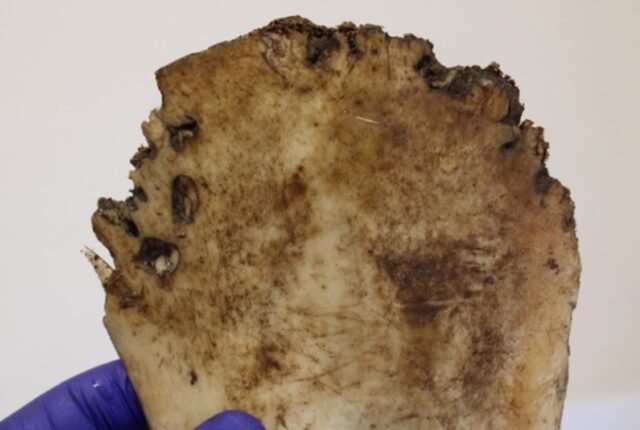It is a regrettable actuality that there’s by no means time to cowl all of the attention-grabbing scientific tales we come throughout every month. Prior to now, we have featured year-end roundups of cool science tales we (virtually) missed. This yr, we’re experimenting with a month-to-month assortment. April’s record consists of new analysis on tattooed tardigrades, the primary stay picture of a colossal child squid, the digital unfolding of a just lately found Merlin manuscript, and an historical Roman gladiator whose skeleton reveals indicators of being gnawed by a lion.
Gladiator vs lion?
Credit score:
Thompson et al., 2025/PLOS One/CC-BY 4.0
Standard depictions of Roman gladiators in fight invariably embody battling not simply human adversaries however wild animals. We all know from surviving texts, imagery, and artifacts that such battles seemingly passed off. However laborious bodily proof is far more restricted. Archaeologists have now discovered the primary direct osteological proof: the skeleton of a Roman gladiator who encountered a wild animal within the enviornment, probably a lion, primarily based on chew marks evident on the pelvic bone, in response to a paper printed within the journal PLoS ONE.
The skeleton in query was that of a younger man, age 26 to 35, buried between 200–300 CE close to what’s now York, England, previously the Roman metropolis of Eboracum. It is certainly one of a number of such skeletons, largely younger males whose stays confirmed indicators of trauma—therefore the suggestion that it may very well be a gladiator burial web site. “We used a technique known as structured gentle scanning [to study the skeleton],” co-author Tim Thompson of Maynooth College informed Ars. “It is a methodology of making a 3D mannequin utilizing grids of sunshine. It is not like X-ray or CT, in that it solely data the floor (not inner) options, however because it makes use of gentle and never X-rays and many others, it’s a lot safer, cheaper, and extra transportable. We’ve got printed a good bit on this and proven its use in each archaeological and forensic contexts.”
The crew in contrast the pelvic lesions discovered on the topic skeleton with chew marks from trendy animal specimens and concluded that the younger man had been bitten by a “giant feline species,” probably a lion scavenging on the physique across the time of loss of life. The younger man was decapitated after loss of life for unknown causes, though this was a ritualistic apply for some individuals throughout the Roman interval. Whereas the proof is technically circumstantial, “we’re assured with our conclusions,” mentioned Thompson. “We have adopted a multidisciplinary strategy to deal with this problem and have drawn on strategies from totally different topics, too. Our use of latest comparability zoological materials is admittedly what offers us the boldness.”
